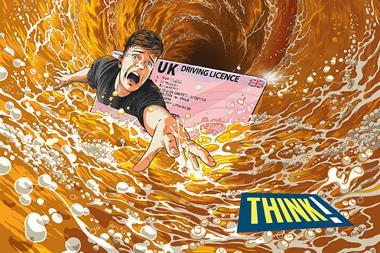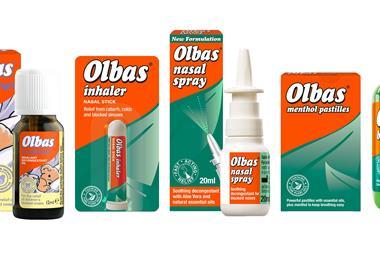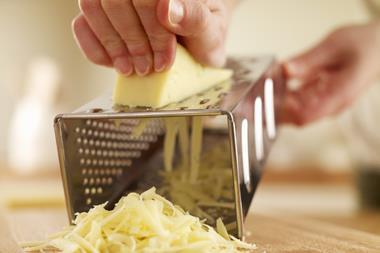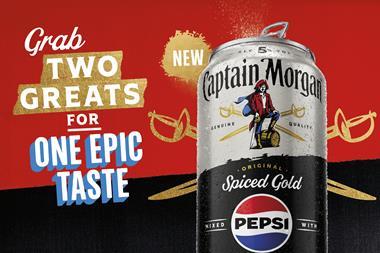There’s a potential clash of the titans looming in the wine aisle in the last few weeks
of the year. In the red corner: celebration. In the blue corner: recession. Which one is your money going to be on?
Alcohol was the leading category in grocery at Christmas last year, worth £3.5bn in the 12 weeks up to the big day, with light wine the top performer (AC Nielsen to December 26, 2007). Drinks were also the most popular present bought in grocery stores, making up 65% of all gifts bought and worth £112m, up 4.4% on the previous year (TNS Gifttrack December 2007).
And in the last few weeks of 2007, sales of wine were 100% higher than the average weekly sales for the rest of the year. But have things changed since then? A recent survey by the Wine and Spirit Trade Association (WSTA) found that wine drinkers were shifting away from the £5-£6 range towards £4-£5 bottles, a result, says WSTA’s Jeremy Beadles, of “the harsh reality facing millions of consumers with budgets squeezed and pressure to reduce spending wherever possible”.
Wine suppliers remain confident that consumers will treat this Christmas like any other. “During the festive season, people want to celebrate in style and are out to impress, so it’s important to capitalise on this opportunity to sell higher-margin brands,” says Pernod Ricard’s Dan Reuby. “Sales of bottles in the £3.50 to £4 segment lose share over Christmas compared with the rest of the year, but sales of wines costing £7 or more grew by 18% last Christmas, so it is essential to match available ranges to customers’ willingness to trade up.”
Customers will, however, be more careful with their spending and look for the reassurance of brands they know. “Customers aren’t always seeking the lowest price product at a time when they are celebrating,” Reuby adds, “But many are looking for strong brands that deliver quality and reliability such as Montana, Jacob’s Creek and Campo Viejo, which all delivered higher average price points than total light wine last Christmas. Jacob’s Creek, he reveals, enjoys the highest consumer awareness of any wine brand, at 91%.
David Mallory, impulse channel controller at Gallo Family Vineyards, makes the same point. “People still want good quality, regardless of what they are spending,” he says. “It is therefore important to stock the most popular wines at every price point. People are also buying wine for gifts and parties, so having a more premium selection at higher price points is important.” Sales of Gallo Family Vineyards and Gallo Family Vineyards Turning Leaf were up 22.7% last Christmas, he says.
Contrast this with the view of Nielsen’s Stewart Blunt, who says that although the value of the wine market has increased this year, that’s a result of rising prices and falling consumer confidence having an impact. “The past 20 weeks have been consistently lower than the same weeks last year, and this does seem likely to continue for the rest of 2008 and so we will sensibly be cautious in our expectations for Christmas this year.”
Nielsen forecasts a 3% drop in wine sales volume on last year, despite a value rise of 5%. The experts agree that retailers will have to work a little harder to maintain sales, and that means putting more effort into promotions and merchandising. Gallo’s Mallory says: “Making a feature of wine will put it at the front of customers’ minds, particularly displaying wine out of section. Blunt adds that “merchandising may well prove to be needed more than ever” and says: “Special offers could be more attractive than before, and making the effort with displays will prompt impulse purchasing.”
And when stocking for the rush, don’t forget rosé. Last Christmas nearly 60% of light wine growth was accounted for by rosé, with sparkling variants in particular gaining share. Jacob’s Creek sparkling rosé topped the charts with an 8% MAT lift at Christmas 2007.
Whatever their economic circumstances, customers will still expect the occasional flying cork this month and if Champagne is beyond their reach, there’s plenty of fizz in the sparkling wine market. While sales of still wines are slowing down, sales of sparkling wine are growing steadily, and with more than eight million UK households purchasing sparkling wine on a regular basis (TNS Homescan) it’s a profitable category with real growth potential in the convenience sector.
“There is now a considerable opportunity for sparkling wine producers to occupy a growing gap in the market: where consumers are reluctant to fork out for a pricey bottle of Champagne, yet would nonetheless like something more ‘special’ than a still wine,” says Claire Griffiths, consumer marketing director for Constellation Europe. “In this ‘premium sparkling’ market, Hardys Crest – currently the number one sparkling brand in the off-trade – is growing by 63% MAT and while France’s sparkling volume sales are currently down 20.9%, Australia is growing fast at 14.6%.”
With drinkers trading down from Champagne and others choosing competitively priced fizz over still wine, total sparkling wine average prices are currently rising, at 5.2%. “We are is confident that we will continue to drive sales of sparkling wine ranges in spite of the tough trading environment, by producing products that respond to consumers’ demands and are supported by significant marketing activity,” Griffiths adds. “The real growth is in branded sparkling wines, and in these value-conscious times, consumers would rather drink a quality sparkling product than a cheap Champagne.” The Hardys brand offers sparkling wines under its Hardys Crest, Stamp and Nottage Hill labels, and a £12m marketing investment in the brand this year includes sponsorship of Lovefilm and a nationwide TV advertising campaign in the run-up to Christmas.
According to the makers of Freixenet, cava – made by the ‘methode traditionelle’ – accounts for more than 50% of the sparkling wine sold in the UK market. The company recommends stocking both standard brut and rosé options.
New to the UK is Codorniu Reina Maria Cristina, a Spanish premium sparkling wine with a rrp of £17.99. Codorniu’s Bill Breen believes there is huge potential for encouraging consumers to trade up from the sub £10 market and promises to “shout loud about Codorniu’s Spanish credentials while helping consumers understand the quality distinctions in traditional sparkling wine”.
Ehrmanns is making a pitch for the same ground with Valdo, an Italian prosecco which it feels will appeal to purchasers of Champagne and cava, the two most popular sparkling wine categories in the UK. Ehrmanns director of marketing Keith Lay is confident that Valdo will prove to be a hit with UK consumers. “We feel there is an opportunity for a prosecco brand leader in the UK and Valdo’s impressive credentials and high level of trade and consumer awareness set it apart,” he says.
Arniston Bay has added its first sparkling variant, a Charmat Brut with a rrp of £7.99.
As sparkling wines are increasingly bought as a spontaneous treat, make sure they are prominently displayed and signposted to encourage impulse purchases. And as customers will want their bubbles ready to drink, keep good quantities in the chiller, particularly early in the evening as Christmas and New Year party-goers make their last-minute visit.
Go low
There's always a profit to be made when two trends meet and this year it's the drop in consumer spending, together with a growing preference for lower-alcohol wines which are creating the opportunity.
Continental Wine and Food (CWF) has recently introduced Silver Bay Point, an 8% abv British wine in red, white and rosé variants at a £2.99 price point. It recommends a 'two for £5' promotion.
CWF marketing manager Vicky Lee says the low-price, low-alcohol approach "ticks all the boxes for the off-trade sector".
She adds: "Retailers can demonstrate to their customers with less disposable income that they can still enjoy a glass of wine at home, and the core female audience will be attracted by the lower-alcohol content," she adds. Silver Bay Point is available through cash and carries.
Constellation has also identified an opportunity for a lighter, lower abv sparkling drink for women new to the wine market, and responded with Echo Falls Spritz, a single-serve 4% abv wine spritzer in Chardonnay and White Zinfandel varietals, recommended to be served chilled or over ice.
Sharing the market is Lambrini - not technically a wine, but looking to appeal to the same target group. Halewood International's Caroline Reynolds predicts that the combination of low abv and good value for money will be "the drivers that will really see light wine-style drinks broaden their appeal in 2009" and recommends that retailers dedicate a section to them adjacent to the wine fixture.
Alcohol-free wines could be more conspicuous in the year ahead after a change to EU regulations which will allow wines produced using innovative alcohol-reducing technologies onto UK shelves.
For Christmas, however, Eisberg's Spritz and Spritz Rosé offer a zero-alcohol sparkling alternative at a £3.99 price point.
Alcohol was the leading category in grocery at Christmas last year, worth £3.5bn in the 12 weeks up to the big day, with light wine the top performer (AC Nielsen to December 26, 2007). Drinks were also the most popular present bought in grocery stores, making up 65% of all gifts bought and worth £112m, up 4.4% on the previous year (TNS Gifttrack December 2007).
And in the last few weeks of 2007, sales of wine were 100% higher than the average weekly sales for the rest of the year. But have things changed since then? A recent survey by the Wine and Spirit Trade Association (WSTA) found that wine drinkers were shifting away from the £5-£6 range towards £4-£5 bottles, a result, says WSTA’s Jeremy Beadles, of “the harsh reality facing millions of consumers with budgets squeezed and pressure to reduce spending wherever possible”.
Wine suppliers remain confident that consumers will treat this Christmas like any other. “During the festive season, people want to celebrate in style and are out to impress, so it’s important to capitalise on this opportunity to sell higher-margin brands,” says Pernod Ricard’s Dan Reuby. “Sales of bottles in the £3.50 to £4 segment lose share over Christmas compared with the rest of the year, but sales of wines costing £7 or more grew by 18% last Christmas, so it is essential to match available ranges to customers’ willingness to trade up.”
Customers will, however, be more careful with their spending and look for the reassurance of brands they know. “Customers aren’t always seeking the lowest price product at a time when they are celebrating,” Reuby adds, “But many are looking for strong brands that deliver quality and reliability such as Montana, Jacob’s Creek and Campo Viejo, which all delivered higher average price points than total light wine last Christmas. Jacob’s Creek, he reveals, enjoys the highest consumer awareness of any wine brand, at 91%.
David Mallory, impulse channel controller at Gallo Family Vineyards, makes the same point. “People still want good quality, regardless of what they are spending,” he says. “It is therefore important to stock the most popular wines at every price point. People are also buying wine for gifts and parties, so having a more premium selection at higher price points is important.” Sales of Gallo Family Vineyards and Gallo Family Vineyards Turning Leaf were up 22.7% last Christmas, he says.
Contrast this with the view of Nielsen’s Stewart Blunt, who says that although the value of the wine market has increased this year, that’s a result of rising prices and falling consumer confidence having an impact. “The past 20 weeks have been consistently lower than the same weeks last year, and this does seem likely to continue for the rest of 2008 and so we will sensibly be cautious in our expectations for Christmas this year.”
Nielsen forecasts a 3% drop in wine sales volume on last year, despite a value rise of 5%. The experts agree that retailers will have to work a little harder to maintain sales, and that means putting more effort into promotions and merchandising. Gallo’s Mallory says: “Making a feature of wine will put it at the front of customers’ minds, particularly displaying wine out of section. Blunt adds that “merchandising may well prove to be needed more than ever” and says: “Special offers could be more attractive than before, and making the effort with displays will prompt impulse purchasing.”
And when stocking for the rush, don’t forget rosé. Last Christmas nearly 60% of light wine growth was accounted for by rosé, with sparkling variants in particular gaining share. Jacob’s Creek sparkling rosé topped the charts with an 8% MAT lift at Christmas 2007.
Whatever their economic circumstances, customers will still expect the occasional flying cork this month and if Champagne is beyond their reach, there’s plenty of fizz in the sparkling wine market. While sales of still wines are slowing down, sales of sparkling wine are growing steadily, and with more than eight million UK households purchasing sparkling wine on a regular basis (TNS Homescan) it’s a profitable category with real growth potential in the convenience sector.
“There is now a considerable opportunity for sparkling wine producers to occupy a growing gap in the market: where consumers are reluctant to fork out for a pricey bottle of Champagne, yet would nonetheless like something more ‘special’ than a still wine,” says Claire Griffiths, consumer marketing director for Constellation Europe. “In this ‘premium sparkling’ market, Hardys Crest – currently the number one sparkling brand in the off-trade – is growing by 63% MAT and while France’s sparkling volume sales are currently down 20.9%, Australia is growing fast at 14.6%.”
With drinkers trading down from Champagne and others choosing competitively priced fizz over still wine, total sparkling wine average prices are currently rising, at 5.2%. “We are is confident that we will continue to drive sales of sparkling wine ranges in spite of the tough trading environment, by producing products that respond to consumers’ demands and are supported by significant marketing activity,” Griffiths adds. “The real growth is in branded sparkling wines, and in these value-conscious times, consumers would rather drink a quality sparkling product than a cheap Champagne.” The Hardys brand offers sparkling wines under its Hardys Crest, Stamp and Nottage Hill labels, and a £12m marketing investment in the brand this year includes sponsorship of Lovefilm and a nationwide TV advertising campaign in the run-up to Christmas.
According to the makers of Freixenet, cava – made by the ‘methode traditionelle’ – accounts for more than 50% of the sparkling wine sold in the UK market. The company recommends stocking both standard brut and rosé options.
New to the UK is Codorniu Reina Maria Cristina, a Spanish premium sparkling wine with a rrp of £17.99. Codorniu’s Bill Breen believes there is huge potential for encouraging consumers to trade up from the sub £10 market and promises to “shout loud about Codorniu’s Spanish credentials while helping consumers understand the quality distinctions in traditional sparkling wine”.
Ehrmanns is making a pitch for the same ground with Valdo, an Italian prosecco which it feels will appeal to purchasers of Champagne and cava, the two most popular sparkling wine categories in the UK. Ehrmanns director of marketing Keith Lay is confident that Valdo will prove to be a hit with UK consumers. “We feel there is an opportunity for a prosecco brand leader in the UK and Valdo’s impressive credentials and high level of trade and consumer awareness set it apart,” he says.
Arniston Bay has added its first sparkling variant, a Charmat Brut with a rrp of £7.99.
As sparkling wines are increasingly bought as a spontaneous treat, make sure they are prominently displayed and signposted to encourage impulse purchases. And as customers will want their bubbles ready to drink, keep good quantities in the chiller, particularly early in the evening as Christmas and New Year party-goers make their last-minute visit.
Go low
There's always a profit to be made when two trends meet and this year it's the drop in consumer spending, together with a growing preference for lower-alcohol wines which are creating the opportunity.
Continental Wine and Food (CWF) has recently introduced Silver Bay Point, an 8% abv British wine in red, white and rosé variants at a £2.99 price point. It recommends a 'two for £5' promotion.
CWF marketing manager Vicky Lee says the low-price, low-alcohol approach "ticks all the boxes for the off-trade sector".
She adds: "Retailers can demonstrate to their customers with less disposable income that they can still enjoy a glass of wine at home, and the core female audience will be attracted by the lower-alcohol content," she adds. Silver Bay Point is available through cash and carries.
Constellation has also identified an opportunity for a lighter, lower abv sparkling drink for women new to the wine market, and responded with Echo Falls Spritz, a single-serve 4% abv wine spritzer in Chardonnay and White Zinfandel varietals, recommended to be served chilled or over ice.
Sharing the market is Lambrini - not technically a wine, but looking to appeal to the same target group. Halewood International's Caroline Reynolds predicts that the combination of low abv and good value for money will be "the drivers that will really see light wine-style drinks broaden their appeal in 2009" and recommends that retailers dedicate a section to them adjacent to the wine fixture.
Alcohol-free wines could be more conspicuous in the year ahead after a change to EU regulations which will allow wines produced using innovative alcohol-reducing technologies onto UK shelves.
For Christmas, however, Eisberg's Spritz and Spritz Rosé offer a zero-alcohol sparkling alternative at a £3.99 price point.



























No comments yet